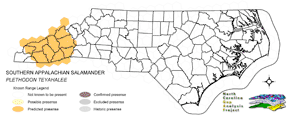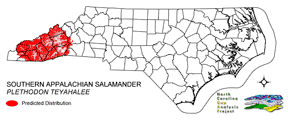
| Taxa: |
| Order: |
| Family: |
| Amphibia |
| Caudata |
| Plethodontidae |
| NatureServe Global Rank: |
| NatureServe State (NC) Rank: |
| G3Q |
| S3? |
| Federal Status: |
| NC State Status: |
| --- |
| W3 |


| Land Unit |
| US Fish & Wildlife Service |
| US Forest Service |
| US National Park Service |
| US Department of Defense |
| NC State Parks |
| NC University System |
| NC Wildlife Res. Com. |
| NC Forest Service |
| NC Div. of Coastal Mgmt. |
| Local Governments |
| Non-Governmental Org. |
| Other Public Lands |
| Private Lands |
| GAP Status 1-2 |
| All Protected Lands |
| Statewide |
| Hectares |
| 0.00 |
| 272,163.69 |
| 61.29 |
| 98,479.98 |
| 2,798.46 |
| 0.00 |
| 7,663.77 |
| 2,211.21 |
| 0.00 |
| 6,813.18 |
| 1,280.61 |
| 0.27 |
| 521,685.72 |
| 136,249.11 |
| 390,962.16 |
| 913,158.18 |
| Acres |
| 0.00 |
| 672,530.99 |
| 151.45 |
| 243,349.28 |
| 6,915.14 |
| 0.00 |
| 18,937.58 |
| 8,318.68 |
| 0.00 |
| 16,835.73 |
| 3,164.46 |
| 0.67 |
| 1,289,113.24 |
| 339,533.48 |
| 968,943.01 |
| 2,259,317.22 |
| % of Dist. on |
| Prot. Lands |
| 0.0 % |
| 69.6 % |
| 0.0 % |
| 25.2 % |
| 0.7 % |
| 0.0 % |
| 2.0 % |
| 0.6 % |
| 0.0 % |
| 0.2 % |
| 0.2 % |
| < 0.1 % |
| 0.0 % |
| 34.8 % |
| ----- |
| ----- |
| % of Dist. on |
| All Lands |
| 0.0 % |
| 29.8 % |
| < 0.1 % |
| 10.8 % |
| 0.3 % |
| 0.0 % |
| 0.8 % |
| 0.2 % |
| 0.0 % |
| 0.7 % |
| 0.1 % |
| < 0.1 % |
| 57.1 % |
| 14.9 % |
| ----- |
| ----- |
|
The range of this salamander covers most of the southern Appalachian mountain region that is south and west of the French Broad river (Wilson 1995). Found primarily in deciduous and mixed forests from the lower slopes to some upper-elevation peaks within its range (Wilson 1995, Petranka 1998). Populations may be concentrated toward the species' upper elevational limits in densely forested settings, coves and other mesic situations (Wilson 1995). Decaying logs and abundant leaf litter on the forest floor are favorite shelter sites for this salamander (Wilson 1995). Also found under rocks (Petranka 1998). NATURE SERVE GLOBAL HABITAT COMMENTS: Birch-beech-hemlock forest with witch hazel, mountain laurel, and rhododendron understory; home range typically includes a retreat hole (Nishikawa 1990). Terrestrial breeder. |
| Code | Name | Description | NC Natural Heritage Program Equivalent |
| 230 | Piedmont Mesic Forest | American Beech - Red Oak - White Oak Forests. | Mesic Mixed Hardwood |
| 383 | Piedmont Mixed Successional Forest | Generally loblolly mixed with successional hardwoods. Sweetgum, tulip poplar and red maple are common co-dominants in these successional forests. | No equivalent |
| 228 | Piedmont Dry-Mesic Oak and Hardwood Forests | Primarily oak dominated forests, white oak is often dominant, with co-dominants including . Also represented by sweetgum and tulip poplar dominated forests. | Dry Mesic Oak Hickory Forest, Basic Oak Hickory Forest, Dry Oak Hickory Forest |
| 382 | Dry Mesic Oak Pine Forests | Mixed forests of the coastal plain and piedmont. Includes loblolly pine with white, southern red and/or post oak and loblolly with water oak. On basic sites of the piedmont, eastern red cedar may co-occur with post, black, and blackjack oaks. | Dry Mesic Oak Hickory Forest, Xeric Hard Pan Forest, Chestnut Oak Forest, Dry Mesic Oak Hickory Forest, Dry Oak Hickory Forest |
| 522 | Northern Hardwoods | High Elevation forests including yellow birch, American beech, and yellow buckeye. Includes forests with Hemlock and Yellow Birch. | Northern Hardwoods Forest, Boulderfield Forest |
| 525 | Appalachian Oak Forest | A variety of oak forest types including Black, White, Scarlet Oaks in dry to mesic situations. Includes forests historically co-dominated by American Chestnut. | High Elevation Red Oak Forest, Montane White Oak Forest |
| 526 | Appalachian Cove Forest | Mixed Mesophytic forests of the mountains. Includes tuliptree, basswood, yellow buckeye and surgar maple. This class is mapped to include cove forests dominated or co-dominated by hemlock. | Rich Cove Forest, Acidic Cove Forest |
| 527 | Appalachian Hemlock | Upland hemlock forests of the moutains region. Vary from side slopes to steep slope positions. | Canada Hemlock Forest |
| 529 | Appalachian Xeric Mixed Forest | Mixed forests with Virginia, Shortleaf, Eastern White Pine, Table Mountain and Pitch pines in combination with xeric oak species. Oaks include, white, Southern Red, black, and rock chestnut. | Pine Oak Heath |
| 530 | Appalachian Xeric Deciduous Forest | Deciduous forests in the mountains dominated by Xeric Oak species. Species include, white, Southern red, black, and rock chestnut. | High Elevation Red Oak Forest, Montane White Oak Forest |
|
Nishikawa, K. C. 1990. Intraspecific spatial relationships of two species of terrestrial salamanders. Copeia 1990:418-426.
Hairston, N. G., Sr. 1993. On the validity of the name TEYAHALEE as applied to a member of the PLETHODON GLUTINOSUS complex (Caudata:Plethodontidae):a new name. Brimleyana 18:65-69. Carr, D. E. 1996. Morphological variation among species and populations of salamanders in the PLETHODON GLUTINOSUS complex. Herpetologica 52:56-65. Hairston, N. G., Sr., et al. 1992. The dynamics of two hybrid zones in Appalachian salamanders of the genus PLETHODON. Evolution 46:930-938. Wilson, L. A. 1995. The Land Manager's Guide to the amphibians and reptiles of the South. Chapel Hill, NC: The Nature Conservancy. Petranka, J. W. 1998. Salamanders of the United States and Canada. Washington DC: Smithsonian Inst. Press. Highton, R. 1987. PLETHODON TEYAHALEE. Cat. Am. Amph. Rep. 401.1-401.2. Highton, R., G. C. Maha, and L. R. Maxson. 1989. Biochemical evolution in the slimy salamanders of the PLETHODON GLUTINOSUS complex in the eastern United States. Illinois Biological Monographs 57:1-153. |
For more information please contact them at:
NC-GAP Analysis Project
Dept. of Zoology, NCSU
Campus Box 7617
Raleigh, NC 27695-7617
(919) 513-2853
www.basic.ncsu.edu/ncgap